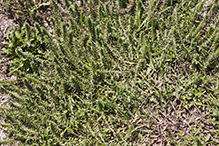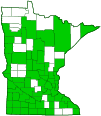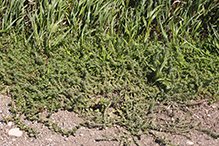bracted vervain
(Verbena bracteata)
Conservation • Wetland • Description • Habitat • Ecology • Use • Distribution • Taxonomy
Description |
Bracted vervain is a 6″ to 18″ tall, annual, biennial, or perennial forb that rises on usually several stems from a taproot. It often forms a circular or semi-circular mat. The stems are 4″ to 20″ long, slightly to moderately 4-angled, widely branched, and loosely spreading. They may be ascending, strongly ascending, or reclining on the ground with the tips ascending (decumbent). They are rarely erect. They are very leafy and are moderately to densely covered with long, white, spreading, straight or slightly curved hairs. The leaves are opposite, lance-shaped to egg lance-shaped or inversely lance-shaped, ⅜″ to 2½″ long, and ⅜″ to 1″ wide. They are stalkless or on short, flat, winged leaf stalks. Lower leaves are usually deeply divided into two narrow lateral lobes and a broad, much larger, terminal lobe. The terminal lobe is often again divided into shallow lobes. The blades are tapered at the base and broadly angled to a blunt tip. They do not clasp the stem. The upper and lower surfaces are moderately to densely covered with white, loosely ascending hairs. The margins are doubly toothed with large, blunt teeth and smaller, sharper teeth. The leaves become smaller and less divided as they ascend the stem. The inflorescence is a solitary spike at the end of the stem and branches. The spikes are ¾″ to 6″ long, ⅜″ to ⅝″ wide, relatively stout, and densely crowded. As the spike elongates through the long blooming season new flowers surround just the growing tip of the spike. The flowers appear singly in the axils of modified leaves (bracts). The bracts are narrowly lance-shaped to narrowly elliptic, coarsely hairy, and 5 ⁄16″ to ⅝″ long. As the spike elongates the bracts become larger, more toothed or lobed, and more leaf-like. Each flower is ⅛″ to ¼″ in diameter. There are 5 sepals, 5 petals, 4 stamens, and 1 style. The sepals are green, and are united at the base into a narrowly bell-shaped tube (calyx), then separated into 5 very short teeth that are unequal in length. The calyx is about ⅛″ long. The bracts are 2 to 4 times longer than the calyx. The petals are light purplish-blue or light purple, and ⅛″to ¼″ long. They are fused at the base into a slender, funnel-shaped tube then separated into 5 spreading lobes. The lobes are 1 ⁄16″ to ⅛″ in diameter and rounded at the tip. Each flower produces a cluster of 4 nutlets that are enclosed in the persistent calyx but are exposed at the tip. Each nutlet is oblong to narrowly oblong in outline and 1 ⁄16″ to ⅛″ long. They are finely ridged on the bottom and have a network of raised ridges above the middle. |
Height |
6″ to 18″ |
Flower Color |
Light purplish-blue or light purple |
Similar Species |
Habitat |
Dry. Prairies, fields, roadsides, sidewalks, and other disturbed sites. Full sun. Sandy, gravelly, or rocky soil. |
Ecology |
Flowering |
May to October |
Pests and Diseases |
|
Use |
|
Distribution |
||
|
Sources |
|
| 8/17/2024 | ||
Nativity |
||
Native |
||
Occurrence |
||
Common and widespread |
||
Taxonomy |
|
Kingdom |
|
Division |
Tracheophyta (Vascular Plants) |
Subdivision |
Spermatophytina (Seed Plants) |
Class |
|
Order |
Lamiales (Mints, Plantains, Olives, and Allies) |
Family |
Verbenaceae (verbena) |
Tribe |
Verbeneae |
Genus |
Verbena (vervains) |
Section |
Verbena |
Series |
Bracteatae |
Subordinate Taxa |
|
|
|
Synonyms |
|
Verbena imbricata Verbena bracteosa Verbena prostrata |
|
Common Names |
|
big-bract vervain bigbract verbena bracted vervain carpet vervain creeping verbena prostrate verbena prostrate vervain |
|
Glossary
Axil
The upper angle where a branch, stem, leaf stalk, or vein diverges.
Bract
Modified leaf at the base of a flower stalk, flower cluster, or inflorescence.
Calyx
The group of outer floral leaves (sepals) below the petals, occasionally forming a tube.
Clasping
Describing a leaf that wholly or partly surrounds the stem but does not fuse at the base.
Decumbent
Reclining on the ground but with the tips ascending.
Sepal
An outer floral leaf, usually green but sometimes colored, at the base of a flower.
Visitor Photos |
||
Share your photo of this plant. |
||
This button not working for you? |
||
|
||
|
||
MinnesotaSeasons.com Photos |
||
 |

Slideshows |
|

Visitor Videos |
||
Share your video of this plant. |
||
This button not working for you? |
||
|
Other Videos |
||
|

Visitor Sightings |
||
Report a sighting of this plant. |
||
This button not working for you? |
||
portapetdr00 |
Location: Pequot Lakes, Minnesota growing on edge of gravel driveway |
MinnesotaSeasons.com Sightings |
||

|
Created: Last Updated: © MinnesotaSeasons.com. All rights reserved. |

